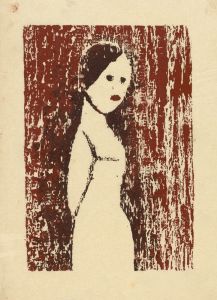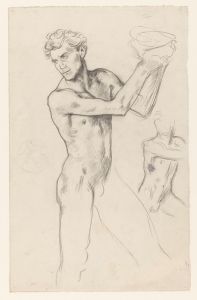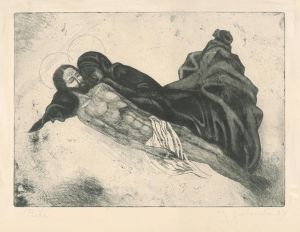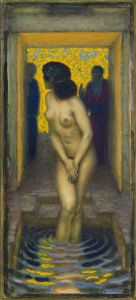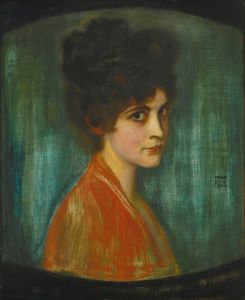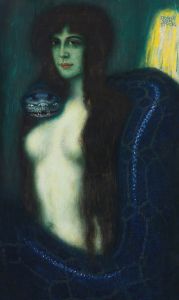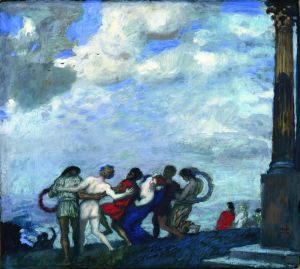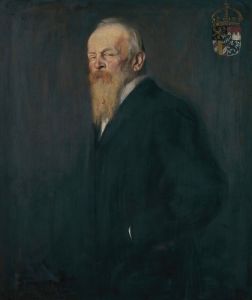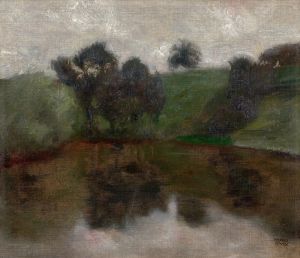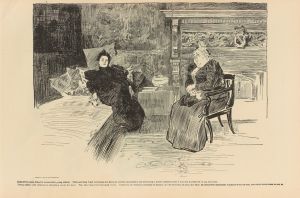
Pietà
A hand-painted replica of Franz von Stuck’s masterpiece Pietà, meticulously crafted by professional artists to capture the true essence of the original. Each piece is created with museum-quality canvas and rare mineral pigments, carefully painted by experienced artists with delicate brushstrokes and rich, layered colors to perfectly recreate the texture of the original artwork. Unlike machine-printed reproductions, this hand-painted version brings the painting to life, infused with the artist’s emotions and skill in every stroke. Whether for personal collection or home decoration, it instantly elevates the artistic atmosphere of any space.
Franz von Stuck was a prominent German painter, sculptor, and architect, known for his contribution to the Symbolist movement in the late 19th and early 20th centuries. One of his notable works is the painting "Pietà," which reflects his distinctive style and thematic interests.
Franz von Stuck was born on February 23, 1863, in Tettenweis, Bavaria, and he rose to prominence as an artist during a period when Symbolism was gaining traction across Europe. Stuck's work often explored themes of mythology, religion, and the human condition, characterized by a dramatic use of light and shadow and a focus on the emotional and psychological aspects of his subjects.
The "Pietà" is a traditional Christian artistic theme that depicts the Virgin Mary cradling the dead body of Jesus Christ after his crucifixion. This theme has been explored by numerous artists throughout history, most famously by Michelangelo in his renowned sculpture housed in St. Peter's Basilica in Vatican City. Stuck's interpretation of the Pietà theme is a painting that captures the somber and poignant moment with his unique Symbolist approach.
In Stuck's "Pietà," the composition is marked by a strong emotional intensity, achieved through his use of color, form, and expression. The figures are often depicted with a sense of stillness and solemnity, emphasizing the tragic nature of the scene. Stuck's background in both painting and sculpture is evident in the way he renders the figures with a sculptural quality, giving them a sense of weight and presence.
The painting reflects Stuck's interest in the interplay between light and shadow, a technique he used to enhance the emotional impact of his work. The use of chiaroscuro, or the contrast between light and dark, is a hallmark of his style, creating a dramatic atmosphere that draws the viewer into the scene. This technique not only highlights the physical forms of the figures but also underscores the spiritual and emotional dimensions of the subject matter.
Stuck's "Pietà" is also notable for its attention to detail and the careful rendering of textures, from the folds of the drapery to the expressions on the faces of the figures. This attention to detail serves to heighten the realism of the scene while maintaining the symbolic and allegorical elements that are characteristic of Symbolist art.
Throughout his career, Franz von Stuck was recognized for his ability to blend traditional themes with modern artistic sensibilities, and his "Pietà" is a testament to this skill. The painting exemplifies his ability to convey deep emotional and spiritual themes through his mastery of form, color, and composition.
Stuck's work, including the "Pietà," has been influential in the development of modern art, particularly in the way it bridges the gap between 19th-century academic traditions and the emerging modernist movements of the early 20th century. His exploration of mythological and religious themes through a Symbolist lens has left a lasting impact on the art world, and his paintings continue to be studied and appreciated for their technical skill and emotional depth.
Franz von Stuck passed away on August 30, 1928, in Munich, but his legacy endures through his contributions to art and his influence on subsequent generations of artists. His "Pietà" remains a significant work within his oeuvre, exemplifying his unique approach to traditional themes and his ability to evoke profound emotional responses through his art.





